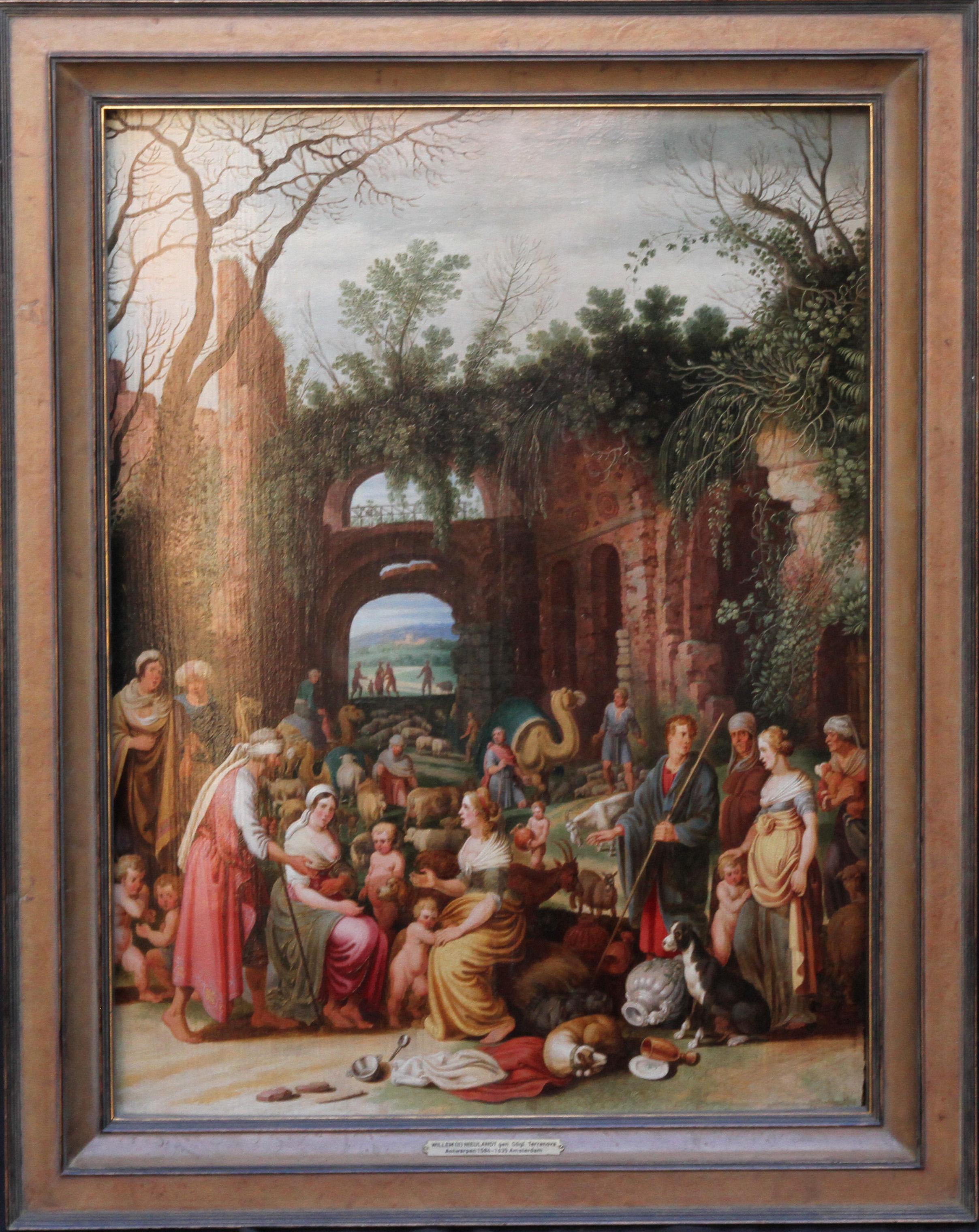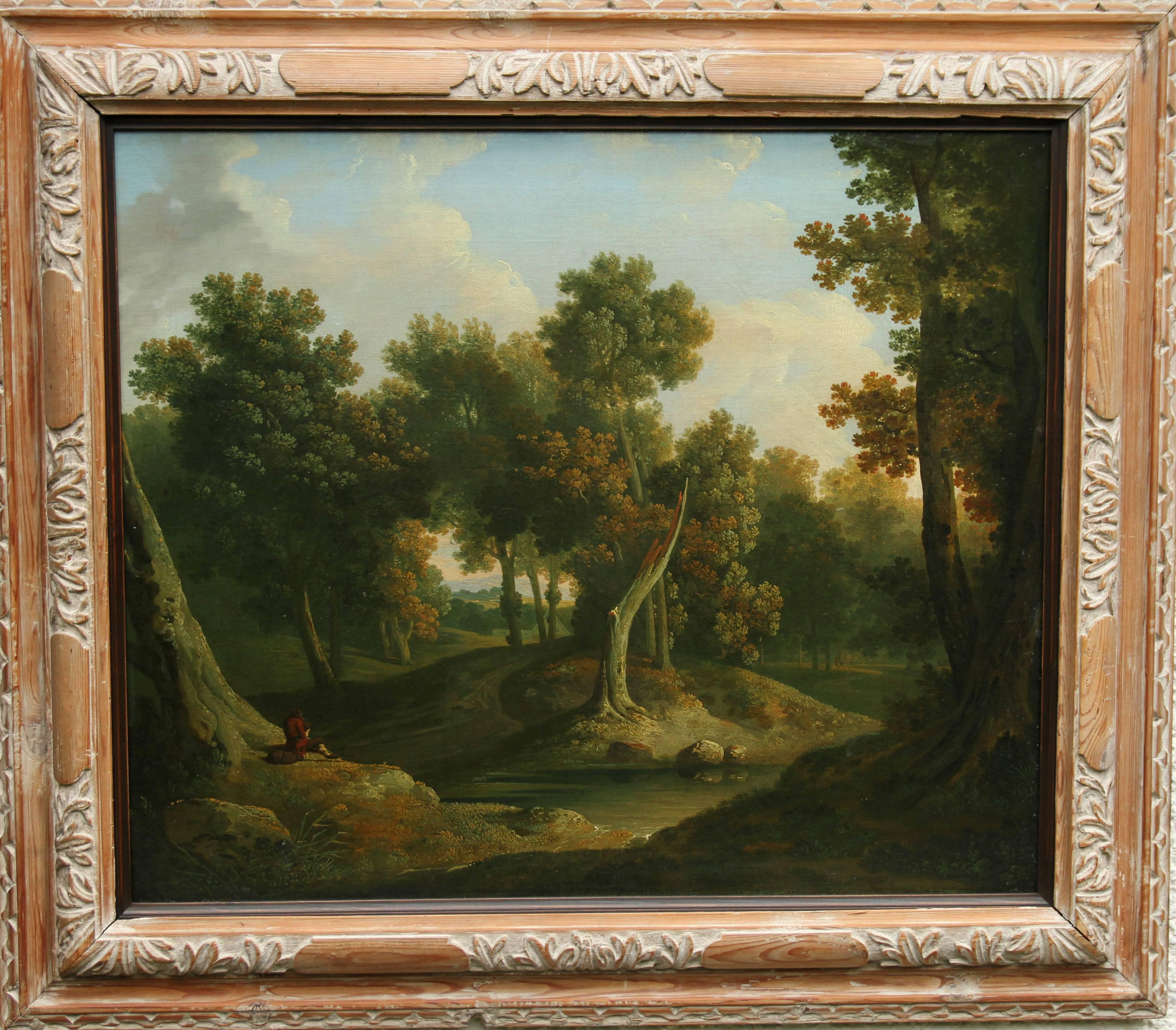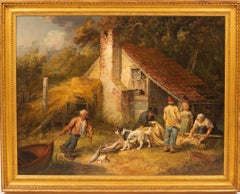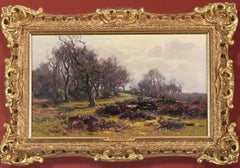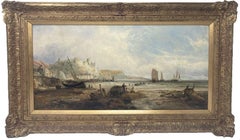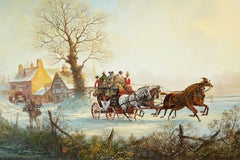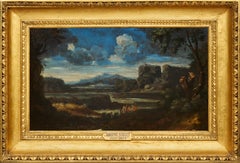Items Similar to BEN MORE, Auchlyne, oil , by Frederick Richard Lee & Thomas Sidney Cooper
Want more images or videos?
Request additional images or videos from the seller
1 of 14
Frederick Richard LeeBEN MORE, Auchlyne, oil , by Frederick Richard Lee & Thomas Sidney Cooper1854
1854
About the Item
BEN MORE FROM AUCHLYNE ROAD oil, by Frederick Richard Lee & Thomas Sidney Cooper
A beautiful 19th century landscape painting of the Scottish mountain (Munro) by the renowned artists Frederick Lee & Thomas Sidney Cooper
The painting is an oil on board, signed by both artists and dated 1854.Housed in a gilt frame.
The image size is 47cm x 62cm, whilst overall the size is 69cm x 85 cm
The painting is in very good condition, having had a light clean. There is some slight crazing to the sky section as to be expected with age, ( see photo close ups with flash) the frame is also in very good condition.
There is a handwritten label verso which reads
Note: According to Cooper, it was during a visit to Lee in Devon that a mutual decision was made to '...paint some pictures conjointly'. Lee was to paint the landscape first and Cooper to introduce the animals - and, at Lee's insistence, to handle the financial arrangements. In the late 1840s both artists were at the height of their popularity and their exhibited collaborations in the Dutch tradition created a 'great sensation' at the Royal Academy when they first appeared.
Prince Albert commented that they had '...caused a new want among patrons' and pronounced them 'the Beaumont and Fletcher of Art'. But by the mid-1850s, however, the art critics were tiring of their annual productions. To what extent the adverse criticism resulted from a gradual resentment from their fellow artists is uncertain. Lee's somewhat cavalier attitude to his profession, which he considered '.
more as a pastime than as a business', together with the surprising rapidity with which both artists could produce large highly finished compositions of undoubted quality, combined with the long list of patrons eager to purchase the results, naturally rankled with artists of lesser talent. Lee and Cooper's nine consecutive years of exhibiting their collaborations at the Royal Academy and elsewhere ended in 1856. However, the fifteen Academy exhibits represent less than a quarter of their total joint productions
Both Cooper and Lee collaborated with other artists, but theirs was by far the most productive and successful partnership. Long after Lee's death at sea in 1879, Cooper was still being approached to add animals into Lee's early paintings.
BEN MORE
Ben More is a mountain in the Breadalbane region of the southern Scottish Highlands, near Crianlarich. Rising to 1,174 metres, it is a Munro and is the highest of the so-called Crianlarich Hills to the south-east of the village. There is no higher land in the British Isles south of Ben More
Frederick Richard Lee
Lee was a prolific artist, based on the number of oil paintings he is known to have produced, both on canvas and on board. His subject matter choices clearly shared influences with John Constable and other contemporaries. Some of his more notable paintings were done in collaboration with Thomas Sidney Cooper (between 1848 and 1856) and Sir Edwin Landseer, Lee painting the landscape and Cooper and Landseer adding the animals. Landscapes and pastoral scenes form the majority of his painting interest, with some exceptions, for example, Cover Side, The Campfire and Gypsy Tent.
Scottish scenes figured prominently as subjects for Lee, but he also traveled extensively elsewhere in Britain and the continent: Gillingham Mill, Dorset; North Duffield Bridge, Derbyshire; Swiss Bridge, Lynedoch; Fulford Park, Exeter; Ben More looking up Glen Dochart; Shattered Oak in Bedfordshire; Sleaford, Lincolnshire; Rock of Gibraltar; and Pont du Gard, are all examples of this.
Thomas Sidney Cooper
One of the finest landscape painters of his day, he is mainly associated with pictures of cattle or sheep,[5] a fact that earned him the epithet "Cow Cooper".[8] Cooper collaborated between 1847 and 1870 with Frederick Richard Lee R.A. on several paintings, Lee undertaking the landscapes, and Cooper adding animals to complete the scene.[9] He travelled round the country, sometimes with his son, painting in Wales, Scotland and the Lake District as well as his home county of Kent.
In London he moved in elevated circles, counting many artists, politicians and writers, including Charles Dickens, as his friends. He had a long acquaintanceship with JMW Turner whom he describes in his autobiography as taking a ‘great interest in me and my success’. Cooper also was favoured by Queen Victoria who invited him to Osborne House on the Isle of Wight.
Cooper was elected an Associate of the Royal Academy (ARA) in 1845 and Royal Academician (RA) on 22 June 1867.
- Creator:Frederick Richard Lee (1798 - 1879, British)
- Creation Year:1854
- Dimensions:Height: 27.17 in (69 cm)Width: 33.47 in (85 cm)
- Medium:
- Movement & Style:
- Period:
- Condition:
- Gallery Location:York, GB
- Reference Number:1stDibs: LU1800215235702
About the Seller
5.0
Vetted Professional Seller
Every seller passes strict standards for authenticity and reliability
Established in 1991
1stDibs seller since 2022
22 sales on 1stDibs
- ShippingRetrieving quote...Shipping from: York, United Kingdom
- Return Policy
Authenticity Guarantee
In the unlikely event there’s an issue with an item’s authenticity, contact us within 1 year for a full refund. DetailsMoney-Back Guarantee
If your item is not as described, is damaged in transit, or does not arrive, contact us within 7 days for a full refund. Details24-Hour Cancellation
You have a 24-hour grace period in which to reconsider your purchase, with no questions asked.Vetted Professional Sellers
Our world-class sellers must adhere to strict standards for service and quality, maintaining the integrity of our listings.Price-Match Guarantee
If you find that a seller listed the same item for a lower price elsewhere, we’ll match it.Trusted Global Delivery
Our best-in-class carrier network provides specialized shipping options worldwide, including custom delivery.More From This Seller
View AllJames ward landscape oil Bringing in the Catch
By James Ward
Located in York, GB
James ward landscape oil Bringing in the Catch
A charming scene of a family "bringing in the catch" showing figures outside a cottage, man pullng in the boat with his dog watching by...
Category
19th Century Old Masters Landscape Paintings
Materials
Oil
New Forest, Hampshire, 19th century, landscape oil, by Frederick Golden Short
By Frederick Golden Short
Located in York, GB
New Forest,Hampshire, 19th century,landscape oil, by Frederick Golden Short
A fine small framed landscape oil painting on canvas o...
Category
19th Century Old Masters Landscape Paintings
Materials
Oil
Hastings Castle oil painting seascape 19th century, William Edward Webb
By William Edward Webb
Located in York, GB
Hastings Castle from the beach oil William Edward Webb
A fine 19th century oil on canvas painting depicting Hastings Castle from the beach with fishermen and boats
housed in a git ...
Category
19th Century Old Masters Landscape Paintings
Materials
Oil
Horses and stagecoach winter/snow scene, oil painting, by John Richard Worsdale
Located in York, GB
A fine antique oil painting of horses pulling a stagecoach in snow , by John richard Worsdale (1869-1947)
The artist portrays this powerful scene with an extensive view, featuring the stagecoach pulled by 4 horses
and a village scene behind with buildings and peopla with another coach behind.
oil on canvas, signed lower left, housed in a gilt frame.
The size of the painting is approx 74 cms x 49 cms, whilst framed size is 90cm x 67cm.
The painting is in very good condition, relined, with only some minor craquelure to the skyline,
The frame appears original and is also in good condition with only minor age wear.
Provenance: The E. W. Towler Collection, formerly of Glympton Park, Woodstock, Oxfordshire.
Eric W. Towler was a remarkable man. He was born in 1900 and left school at the age of 12 to work in a Yorkshire pit and through a lifetime of hard work, self-improvement, luck and a refusal to limit his horizons achieved many of his aspirations.
As a Yorkshireman through and through, he believed in ‘spending the brass in his pocket’ and over time he was successful enough to acquire enough ‘brass’ to enable his purchase of Glympton Park and furnish it as a traditional country house with all the trappings – in his case collections of antique furniture...
Category
Late 19th Century Old Masters Landscape Paintings
Materials
Oil
St Michael's Mount, Cornwall Seascape Oil
Located in York, GB
This early 20th century oil on canvas depicts a nautical scene with a view of St Michaels Mount beyond.
Although as yet, not attributed to a particular artist,this painting has cl...
Category
Early 20th Century Old Masters Landscape Paintings
Materials
Oil
19th century oil, view London, the Thames, houses parliament, Francis Maltino
Located in York, GB
A fine pair of oil paintings, oil on board depicting views of the Thames one showing houses of parliament the other barges in busy shipping lane.
Framed and Glazed the size being 26 ...
Category
19th Century Old Masters Landscape Paintings
Materials
Oil
You May Also Like
Italian Landscape with Jack Players, a painting by Gaspard Dughet (1615 - 1675)
By Gaspard Dughet
Located in PARIS, FR
Here Gaspard Dughet offers us an idyllic vision of the Roman countryside. The stages follow one another in a perfectly structured composition, revealing here a lake, there travellers walking along, gradually leading our eye to the blue horizon. But behind its classical composition, this landscape is particularly interesting because of three anthropomorphic details that the artist has hidden, opening the way to a radically different interpretation...
1. Gaspard Dughet, a landscape artist in the light of Poussin
Gaspard Dughet was born on June 4th, 1615 in Rome where his father, of French origin, was a pastry cook. He was probably named Gaspard in honour of his godfather Baron Gaspard de Morant, who was, or may have been, his father's employer. His older sister Jeanne married the painter Nicolas Poussin (1594 - 1655) on September 1st, 1630. The young Gaspard was apprenticed with his brother-in-law at the beginning of 1631, which led his entourage to name him Gaspard Poussin. The first preserved works of the painter date from the years 1633-1634 and were painted in Poussin’s studio.
Around 1635, Gaspard Dughet became emancipated and began to frequent the Bamboccianti circle. In 1636, he became friends with the painter Jean Miel (1599 - 1656), but also with Pier Francesco Mola (1612 - 1666) and Pietro da Cortona (1596 - 1669).
This was also the time of his first trips throughout Italy. The painter, although of French origin, appears never to have visited France. In 1646 he settled permanently in Rome. A recognized painter with a solid book of orders, he remained faithful to landscape painting throughout his life, alternating between cabinet paintings and large decorative commissions, using both oil and fresco.
Nailed to his bed by rheumatic fever at the age of 58, he died on May 25, 1675.
2. Discovering an idealized landscape
Beyond a relatively dark foreground that takes us into the landscape, we discover a vast bluish horizon: a plateau surrounded by deep ravines advances to the right, overhanging an expanse of water that sparkles below. A road winds through a mountainous mass as if leading us to the fortress that crowns it; another town appears in the distance at the foot of three conical mountains.
The composition is rigorous, mineral, and structured by geometric volumes. The various stages in the landscape lead one to the next attracting the eye towards the horizon located in the middle of the canvas. The general impression is that of a welcoming and serene nature.
In many places the paint layer has shrunk, or become transparent, revealing the dark red preparation with which the canvas was covered and accentuating the contrasts.
Human presence is limited to three jack players, leaning against a mound in the foreground. Their long garments, which may evoke Roman togas, contribute to the timelessness of the scene.
Close examination of the canvas reveals two other travellers on the path winding between the rocks. Made tiny by the distance, their introduction in the middle register, typical of Dughet's art, lengthens the perspective.
While it is difficult to date the work of a painter who devoted his entire life to the representation of landscapes, it is certain that this painting is a work from his later years. The trees that occupied the foreground of his youthful compositions have been relegated to the sides, a stretch of water separates us from the arid mountains counterbalanced by two trees represented on the opposite bank. The introduction of this stretch of water in the middle of the landscape betrays the influence of the Bolognese and in particular of the Dominiquin (1581 - 1641)
A number of similarities with a drawing in the British Museum might suggest a date around 1656-1657, since, according to Marie-Nicole Boisclair , it has been compared with the Prado's Landscape with the Repentant Magdalene, painted at that period.
3. Three amazing anthropomorphic details
While some late Renaissance landscapes offer a radical double reading, allowing one to see both a face or a human body behind the representation of a landscape, it seems interesting to us to hypothesize that Gaspard Dughet had fun here by slipping in a few details that, taken in isolation, evoke human or animal figures.
We will give three examples, looking closely at a cloud, the trunk of a broken tree and the top of a cliff.
The main cloud could thus evoke a Christ-like face or that of an antique god...
Category
1650s Old Masters Landscape Paintings
Materials
Oil
Laban Demanding the Return of the Teraphim from Rachel - Dutch Old Master art
By Willem van Nieulandt II
Located in London, GB
This very busy oil on panel is a Dutch Old Master painting dating to around 1620 by artist and poet Willem van Nieulandt. It is an incredibly detailed and colourful scene composed of...
Category
17th Century Old Masters Figurative Paintings
Materials
Oil
Villagers in a Landscape - Flemish 17thC art figurative landscape oil painting
Located in London, GB
This fantastic Flemish 17th century Old Master oil painting is by Thomas Van Apshoven. It was painted circa 1650 and depicts a village with figures outside a tavern, eating, drinking and dancing. Beyond are more dwellings, villagers and animals, all under a blue summer's sky. The detail, brushwork and vibrant colouring are superb. This is an excellent example of Apshoven's work and a typical subject he loved to paint.
Provenance. Leominster estate.
Wax stamp verso.
Condition. Oil on panel, 22 inches by 17 inches and in good condition.
Frame. Housed In beautiful gilt frame, 30 inches by 25 inches and in good condition.
Thomas van Apshoven (1622– 1664) was a Flemish painter known for his landscapes with peasant scenes and genre scenes in interiors. His genre scenes depict village festivals, the interiors of taverns, village scenes or landscapes with peasants engaged in various activities, singeries, guardroom scenes and laboratories of alchemists. Some still lifes have also been attributed to him. His themes and style are close to that of David Teniers the Younger. He was born on 30 November 1622 in Antwerp as the eldest son of Ferdinand van Apshoven the Elder and Leonora Wijns. His father was a painter who had studied with Adam van Noort and had become a master of the Antwerp Guild of Saint Luke in 1596. No paintings by his father are known. His younger brother Ferdinand van Apshoven the Younger became also a successful painter. Thomas studied under his father. Some sources state that he became a pupil of the prominent genre painter David Teniers the Younger. It is more likely, however, that he was an imitator of Teniers. He was registered as a 'wijnmeester' [son of a master] in the Guild of St. Luke of Antwerp in the guild year 1645–1646. He married Barbara Janssens on 22 March 1645. The couple had four children. The godfathers of the children included the painters Victor Wolfvoet...
Category
1650s Old Masters Figurative Paintings
Materials
Oil
Old Master Wooded Landscape - Irish 1830 art woodland oil painting
By James Arthur O'Connor
Located in London, GB
A delightful large oil on canvas of a wooded landscape which dates to circa 1830 and is attributed to Irish artist James Arthur O’Connor. A superb painting and an excellent example o...
Category
18th Century Old Masters Landscape Paintings
Materials
Oil
$43,453 Sale Price
20% Off
Italian Landscape with Travellers - Dutch Golden Age 17thC art oil painting
Located in London, GB
This superb Dutch Golden Age Old Master landscape oil painting is attributed to Jacob van der Croos. Painted circa 1670 it is an Italianate landscape with figures and their animals i...
Category
17th Century Old Masters Landscape Paintings
Materials
Oil
$17,381 Sale Price
20% Off
Village Scene Figures & Animals - British Old Master exh pastoral oil painting
By James Ward
Located in London, GB
This stunning British Old Master exhibited pastoral oil on panel is by noted artist James Ward. Painted circa 1815 with superb provenance, it was e...
Category
1810s Old Masters Animal Paintings
Materials
Oil
James WardVillage Scene Figures & Animals - British Old Master exh pastoral oil painting, Circa 1815
$130,360 Sale Price
20% Off

